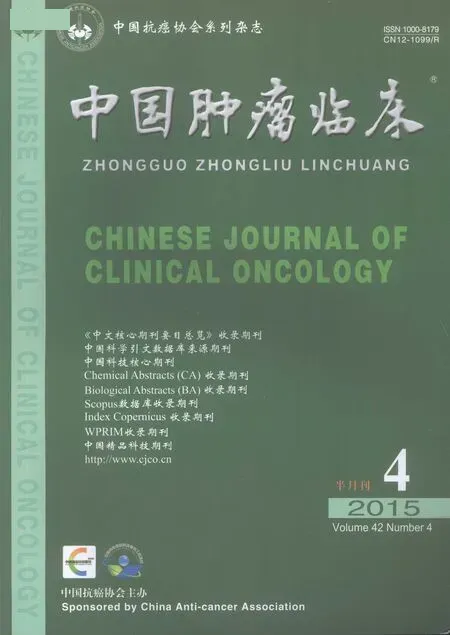调强放疗结合诱导化疗或同期加辅助化疗治疗局部晚期鼻咽癌的疗效比较
丘文泽黄培钰施君理夏海群赵充曹卡加
·临床研究与应用·
调强放疗结合诱导化疗或同期加辅助化疗治疗局部晚期鼻咽癌的疗效比较
丘文泽①黄培钰①施君理②夏海群①赵充①曹卡加①
目的:比较诱导化疗加调强放疗和同期放化疗加辅助化疗治疗局部晚期鼻咽癌的疗效。方法:收集2004年1月至2008年12月中山大学肿瘤医院收治的经病理证实的局部晚期鼻咽癌240例,其中采用顺铂+5-FU诱导化疗加调强放疗(诱导组)117例,采用顺铂、调强放疗同期放化疗加顺铂+5-FU辅助化疗(同期组)123例。应用Kaplan-Meier和Log-rank法计算和比较两组患者的生存率。结果:诱导组和同期组的5年总生存率、无瘤生存率、无转移生存率、无鼻咽复发生存率和无颈部复发生存率分别为78.0%和78.7%、68.9%和67.5%、79.0%和77.0%、91.6%和91.0%、95.3%和93.7%,两组比较差异无统计学意义(P>0.05)。同期组Ⅲ、Ⅳ级恶心呕吐和白细胞减少的发生率明显高于诱导组。多因素分析结果显示N分期和年龄是影响局部晚期鼻咽癌患者总生存的预后独立因素。结论:诱导化疗加调强放疗治疗局部晚期鼻咽癌的疗效达到同期放化疗加辅助化疗的水平,远处转移是局部晚期鼻咽癌治疗失败的主要原因。
鼻咽癌 调强放疗 诱导化疗 同期放化疗 辅助化疗
局部晚期鼻咽癌治疗失败的主要原因是局部复发和远处转移[1-2],放疗加化疗可减少复发,降低远处转移率,提高治疗效果[3-4]。有研究结果显示,应用同期放化疗和辅助化疗治疗局部晚期鼻咽癌取得较好的疗效,但同期放化疗的急性毒副反应较重,患者依从性较差,约40%患者因急性毒副反应而无法按计划完成化疗,甚至个别患者被迫暂时中断放射治疗,影响鼻咽癌的治疗效果[3,5]。因此,化疗何时介入局部晚期鼻咽癌的放射治疗是鼻咽癌研究的一项重要内容。有研究比较同期放化疗后加与不加辅助化疗对局部晚期鼻咽癌的影响,结果显示疗效影响不明显[6-7]。Huang等[5]应用诱导化疗加放射治疗或诱导化疗加同期放化疗治疗局部晚期鼻咽癌,但两组患者疗效无显著性差异。有研究采用诱导化疗加同期放化疗和同期放化疗治疗局部晚期鼻咽癌,两组患者的生存率也无显著性差异[8-10]。本研究分析和比较诱导化疗加调强放疗与同期放化疗加辅助化疗治疗局部晚期鼻咽癌的疗效。
1 材料与方法
1.1材料
入组标准:病理证实为Ⅱ~Ⅲ型(WHO)鼻咽癌初治患者;年龄18~65岁;2002年UICC分期标准为Ⅲ~Ⅳb期;无远处转移;Karnofsky评分≥70分;血常规和肝肾功能正常;采用调强放疗(IMRT);接受PF诱导化疗2个疗程或接受顺铂同期放化疗2个疗程加PF辅助化疗2个疗程。2004年1月至2008年12月中山大学肿瘤医院收治的鼻咽癌患者中,符合上述条件共240例。其中男性175例,女性65例,中位年龄44岁。两组患者的年龄、性别、临床分期、病理类型等临床资料比较差异无统计学意义(P>0.05,表1)。
1.2方法
1.2.1放射治疗全部病例采用IMRT。鼻咽大体肿瘤体积(GTVnx)和颈部转移淋巴结体积(GTVnd)根据MR或CT显示的鼻咽肿瘤和颈部淋巴结勾画。临床靶区1(CTV1)为GTVnx外扩5~10 mm,并包括全部鼻咽黏膜以及黏膜下5 mm;临床靶区2(CTV2)包括颅底、后组筛窦、蝶窦底部、翼突、翼腭窝、卵圆孔、鼻腔后1/3、咽旁间隙、咽后间隙等鼻咽肿瘤可能侵犯的区域,以及需要预防照射的颈部淋巴引流区。计划靶区(PTV)在CTV基础上三维方向各外扩3~5 mm。GTVnx、GTVnd、CTV1、CTV2各自对应的PTV处方剂量分别为68~70 Gy、64~68 Gy、60 Gy和54 Gy,每周5次,共30次。
1.2.2化学治疗诱导组(IC+RT组117例)诱导化疗采用DDP+5-FU(DDP 80 mg/m2,d1;5-FU 4 g/m2,d1~5),每3周为1个疗程,共2~3个疗程。同期组(CCRT+AC组123例)在放射治疗的同时单用DDP(80 mg/m2),每3周为1个疗程,共2~3个疗程;放疗后再采用DDP+5-FU(DDP 80 mg/m2,d1;5-FU 4 g/m2,d1~5),每3周为1个疗程,共2~3个疗程。
1.2.3疗效评价临床疗效评价采用实体瘤治疗疗效评价标准(RECIST 1.1),治疗相关毒性反应评价采用国际常见不良反应标准第3版(CTCAE v3.0)。
1.2.4随访放射治疗后前3年每3个月、第4~5年每6个月、5年后每年随访1次。随访内容包括:体格检查、MR或CT、腹部彩超、胸片、EBV-DNA和VCA-IgA等,必要时行鼻咽电子镜、同位素骨扫描和PET-CT等检查。

表1 两组鼻咽癌患者临床资料比较Table 1Comparison of clinical data of patients between the two groups
1.3统计学方法
采用SPSS 13.0软件进行数据分析。患者的临床资料和毒副反应采用χ2或t检验,生存率采用Kaplan-Meier方法计算,组间比较采用Log-rank法。应用Cox风险回归模型进行多因素分析。P<0.05为差异有统计学意义。
2 结果
2.1随访情况
随访至2014年2月,所有病例随访时间超过5
年。死亡病例共55例,其中放射治疗后5年内死亡41例,5年后死亡14例。
2.2生存分析
诱导组和同期组的5年总生存率、无瘤生存率、无转移生存率、无鼻咽复发生存率和无颈部复发生存率分别为78.0%和78.7%、68.9%和67.5%、79.0%和77.0%、91.6%和91.0%、95.3%和93.7%,两组比较差异无统计学意义(P>0.05,图1)。

图1 两组鼻咽癌患者生存率比较Figure 1Comparison of survival of patients with loco-regionally advanced nasopharyngeal carcinoma by treatment group(IC+RT vs.CCRT+AC)
分层分析显示,诱导组和同期组Ⅲ期患者的5年总生存率、无瘤生存率、无转移生存率、无鼻咽复发生存率和无颈部复发生存率分别为87.9%W T.83.8%、78.8%W T.70.5%、87.8%W T.82.5%、96.9%W T.93.2%和95.3%W T.89.1%,两者比较差异无统计学意义(P>0.05)。
诱导组和同期组Ⅳ期患者的5年总生存率、无瘤生存率、无转移生存率、无鼻咽复发生存率和无颈部复发生存率分别为64.3%W T.69.1%、55.4%W T.61.9%、66.3%W T.66.8%、83.5%W T.86.3%和95.3%W T.100%,两者比较差异无统计学意义(P>0.05)。
2.3治疗失败模式
诱导组复发或(和)转移35例(29.9%),同期组为44例(35.8%),两组比较差异无统计学意义(P>0.05)。两组病例治疗失败模式见表2。
2.4相关毒性反应
两组病例治疗相关的急性毒性反应见表3。161例无瘤生存≥5年患者的晚期毒性反应见表4。
2.5预后影响因素
将性别、年龄、分组、临床分期、T分期、N分期和病理类型等因素行单因素分析,结果显示年龄、临床分期、T分期、N分期是影响局部晚期鼻咽癌总生存的预后因素。再将所有因素纳入Cox风险回归模型对总生存率进行多因素分析(表5),结果显示N分期(P=0.004)和年龄(P<0.001)是局部晚期鼻咽癌总生存的独立预后因素。

表2 两组鼻咽癌患者治疗失败模式比较Table 2Comparison of failure patterns of patients in the two groups

表4161 例无瘤生存≥5年鼻咽癌患者的晚期毒性反应Table 4Late toxic reactions in 161 patients with disease-free survival of 5 years or over

表5 局部晚期鼻咽癌多因素Cox回归分析Table 5Multivariate analysis of prognostic factors for OS of patients with loco-regionally advanced NPC
3 讨论
本研究结果显示,诱导组患者5年总生存率、无瘤生存率、无转移生存率、无鼻咽复发生存率和无颈部复发生存率均达到同期组的水平。分层分析结果同样显示,无论Ⅲ期还是Ⅳ期患者,两组5年总生存率、无瘤生存率、无转移生存率、无鼻咽复发生存率和无颈部复发生存率均无显著性差异。主要原因可能为:1)诱导化疗后,鼻咽和颈部肿物缩小,肿瘤的血液供应得到不同程度改善,放射抗拒的乏氧细胞减少,肿瘤的放射敏感性增加,从而使肿瘤得到有效的控制。本组患者诱导化疗后,CR 5例,PR 93例,SD 19例。2)本研究采用治疗效果较好的IMRT治疗,IMRT较高的肿瘤局部控制率可能削弱两组患者疗效之间的差异。
采用IMRT治疗鼻咽癌后,治疗效果有所提高,但治疗失败的模式无改变。研究结果显示,远处转移仍是鼻咽癌治疗失败的主要原因[1-2]。本研究中有56例(23.3%)患者发生远处转移,成为鼻咽癌治疗失败的首位原因。诱导组远处转移24例(20.5%),同期组32例(26.0%),两组比较差异无统计学意义。因此,同期组鼻咽癌患者治疗后远处转移无减少。同期组多数患者行2个疗程的同期化疗和2个疗程的辅助化疗,上述研究结果与化疗的疗程数是否有关尚需进一步研究。
同期放化疗加辅助化疗的毒副反应不容忽视[11]。本研究中,同期组全部患者均完成同期化疗2个疗程和辅助化疗2个疗程。同期组Ⅲ、Ⅳ级恶心呕吐的发生率明显高于诱导组,Ⅲ、Ⅳ级白细胞减少的病例数也明显多于诱导组。前者多发生在同期放化疗期间,后者多出现在辅助化疗期间,这可能与患者经过放化疗后进食减少,营养欠佳或化疗毒性反应的累积有关。

表3 两组鼻咽癌患者急性毒性反应比较Table 3Comparison of severe(grade 3 or 4)acute toxic reactions of patients in the treatment groups
IMRT的应用使鼻咽癌放射后遗症的发生率和严重程度大幅改善[12-14],尤其是皮肤、口干和放射性脑病等晚期反应明显下降。本组患者中,共发生放射性脑病5例(3.1%)。除1例双侧外,均为单侧颞叶损伤。同期组放射性脑病的发生率为3.8%(3例),与诱导组的2.4%(2例)比较有增高趋势。Su等[15]研究显示鼻咽癌IMRT后放射性颞叶损伤的发生率为4.6%。Zhou等[16]研究表明鼻咽癌IMRT后放射性颞叶损伤的发生率为7.5%。本研究中患者放射性脑病的发病率似乎低于相关研究所报道的数据,与未进行统计的79例治疗失败患者的放射性脑病发生率较高是否有关值得进一步研究。同期组患者皮肤、口干和听力下降的1、2级反应的发生率也有增高的趋势,这是否与诱导化疗后鼻咽肿瘤体积(GTVnx)缩小,使脑、腮腺等正常器官组织得到更好保护有无关联值得进一步研究。在本研究中,同期组和诱导组的临床分期相似,但诱导组的GTVnx体积为(57.50± 33.92)cm3,而同期组为(72.56±40.76)cm3,两组比较差异有统计学意义(P=0.002)。
综上所述,本研究结果表明,诱导化疗加调强放疗治疗局部晚期鼻咽癌的疗效达到了同期放化疗加辅助化疗的水平,远处转移是局部晚期鼻咽癌治疗失败的主要原因,进一步的结论仍需大样品的前瞻性临床研究加以证实。
1Wang R,Wu F,Lu H,et al.Definitive intensity-modulated radiation therapy for nasopharyngeal carcinoma:long-term outcome of a multicenter prospective study[J].J Cancer Res Clin Oncol,2013,139(1):139-145.
2Wu F,Wang R,Lu H,et al.Concurrent chemoradiotherapy in locoregionally advanced nasopharyngeal carcinoma:Treatment outcomes of a prospective,multicentric clinical study[J].Radiother Oncol,2014,112(1):106-111.
3Al-Sarraf M,LeBlanc M,Giri PG,et al.Chemoradiotherapy versus radiotherapy in patients with advanced nasopharyngeal cancer: phase III randomized Intergroup study 0099[J].J Clin Oncol,1998,16(4):1310-1317.
4Chen Y,Sun Y,Liang SB,et al.Progress report of a randomized trial comparing long-term survival and late toxicity of concurrent D IFNPSBEJPU IFSBQ ZXJU I BEK V W BO U D IFNPU IFSBQ ZW FST V TSBEJPU IFSBQ Z alone in patients with stage III to IVB nasopharyngeal carcinoma from endemic regions of China[J].Cancer,2013,119(12):2230-2238.
5Huang PY,Cao KJ,Guo X,et al.A randomized trial of induction chemotherapy plus concurrent chemoradiotherapy versus induction chemotherapy plus radiotherapy for locoregionally advanced nasopharyngeal carcinoma[J].Oral Oncology,2012,48(10):1038-1044.
6Chen L,Hu CS,Chen XZ,et al.Concurrent chemoradiotherapy QMV TBEK V W BO UD I FNPU I FSBQZW FST V TD PO D V SSFO UD I FNPSBEJPU I FSBQ Z alone in patients with locoregionally advanced nasopharyngeal carcinoma:a phase 3 multicentre randomised controlled trial[J].The Lancet Oncology,2012,13(2):163-171.
7Liang Z,Zhu X,Li L,et al.Concurrent chemoradiotherapy fol-MPXFE CZ BEK V WB O U D I FNPU I FSBQ Z D PNQ BSFE XJU ID PO D V SSFO U chemoradiotherapy alone for the treatment of locally advanced nasopharyngeal carcinoma:a retrospective controlled study[J].Current oncology,2014,21(3):e408-417.
8He F,Luo W,Zhang Q,et al.Retrospective analysis of effectiveness of intensity-modulated radiotherapy combined with chemotherapy or not for locoregionally advanced nasopharyngeal carcinoma[J].Natl Med J China,2013,93(29):2292-2295.[何妨,罗伟,张群,等.单纯调强放射治疗或结合化疗对局部区域晚期鼻咽癌的疗效观察[J].中华医学杂志,2013,93(29):2292-2295.]
9Liang ZG,Zhu XD,Tan AH,et al.Induction chemotherapy followed by concurrent chemoradiotherapy versus concurrent chemo-SB EJPU I FSBQZXJU I PS XJU I PV UBEK V W BO UD I FNPU I FSBQ Z G PS M PD PSF-gionally advanced nasopharyngeal carcinoma:meta-analysis of 1,096 patients from 11 randomized controlled trials[J].Asian Pac J Cancer Prev,2013,14(1):515-521.
10 Liang XX,Xie FY,Zhang Y,et al.Induction chemotherapy combined with concurrent chemoradiotherapy versus simple concomitant chemoradiotherapy for locoregionally advanced nasopharyngeal carcinoma[J].Chin J Clin Oncol,2013,40(8):202-207.[梁雪霞,谢方云,张允,等.诱导化疗联合同期放化疗与同期放化疗治疗局部晚期鼻咽癌的对比研究[J].中国肿瘤临床,2013,40(8):202-207.]
11 Sun X,Su S,Chen C,et al.Long-term outcomes of intensity-modulated radiotherapy for 868 patients with nasopharyngeal carcinoma:an analysis of survival and treatment toxicities[J].Radiother Oncol,2014,110(3):398-403.
12 Zeng L,Tian YM,Sun XM,et al.Late toxicities after intensity-modulated radiotherapy for nasopharyngeal carcinoma:patient and treatment-related risk factors[J].Br J Cancer,2014,110(1):49-54.
13 Peng G,Wang T,Yang KY,et al.A prospective,randomized study comparing outcomes and toxicities of intensity-modulated radiotherapy vs.conventional two-dimensional radiotherapy for the treatment of nasopharyngeal carcinoma[J].Radiother Oncol,2012,104(3):286-293.
14 Mao YP,Zhou GQ,Liu LZ,et al.Comparison of radiological and clinical features of temporal lobe necrosis in nasopharyngeal carcinoma patients treated with 2D radiotherapy or intensity-modulated radiotherapy[J].Br J Cancer,2014,110(11):2633-2639.
15 Su SF,Huang Y,Xiao WW,et al.Clinical and dosimetric character-JT U JD TPGU FNQP SBM M PCFJO K V SZ G PM M PXJO HJO U FO T JU Z NPEV M BU FE SBEJP-therapy of nasopharyngeal carcinoma[J].Radiother Oncol,2012,104(3):312-316.
16 Zhou GQ,Yu XL,Chen M,et al.Radiation-induced temporal MPCF JO K V SZ G PSO BT PQIBSZO H FBM D BSD JO PNB?BD PNQ BSJT POPGJO U FO T J-ty-modulated radiotherapy and conventional two-dimensional radiotherapy[J].PloS One,2013,8(7):e67488.
(2014-10-15收稿)(2015-01-13修回)
(编辑:邢颖)
Comparison of efficacy of induction chemotherapy plus intensity-modulated radiotherapy and concurrent chemo-radiotherapy plus adjuvant chemotherapy for patients with loco-regionally advanced nasopharyngeal carcinoma
Wenze QIU1,Peiyu HUANG1,Junli SHI2,Haiqun XIA1,Chong ZHAO1,Kajia CAO1
Kajia CAO;E-mail:caokajia@163.com
Objective:To compare the efficacy of induction chemotherapy(IC)plus intensity-modulated radiotherapy(IMRT) with that of concurrent chemo-radiotherapy(CCRT)plus adjuvant chemotherapy(AC)for patients with loco-regionally advanced nasopharyngeal carcinoma(NPC).Methods:Data of 240 patients with loco-regionally advanced NPC were reviewed.These patients were admitted to the Sun Yat-sen University Cancer Center between January 2004 and December 2008.Among the 240 patients,117 underwent the IC+IMRT and 123 were treated with the CCRT+AC.The IC+IMRT group received a regimen including cisplatin and 5-fluorouracil(5-FU).The CCRT+AC group received cisplatin concurrently with radiotherapy and subsequently received adjuvant cisplatin and 5-FU.The survival rates of the patients were assessed by Kaplan-Meier analysis,and the survival curves were compared by Log-rank test.Multivariate analysis was conducted using Cox proportional hazard regression model.Results:The 5-year overall survival(OS), disease-free survival,distant metastasis-free survival,local relapse-free survival,and the nodal relapse-free survival were 78.0%versus 78.7%,68.9%versus 67.5%,79.0%versus 77.0%,91.6%versus 91.0%,and 95.3%versus 93.7%in the IC+IMRT and CCRT+AC groups,respectively.The survival between the two groups exhibited no significant differences.Higher rates of Grades 3 to 4 nausea-vomiting(8.1%vs.1.7%,P=0.023)and leukopenia(9.7%vs.0.9%,P=0.006)were observed in the CCRT+AC group.Multivariate analysis revealed that N stage and age were significant prognostic factors for the OS of the patients with loco-regionally advanced NPC. Conclusion:The treatment outcomes of IC+IMRT and CCRT+AC were similar.Distant metastasis remained as the predominant mode of treatment failure.
nasopharyngeal carcinoma,intensity-modulated radiotherapy,induction chemotherapy,concurrent chemo-radiotherapy,adjuvant chemotherapy

10.3969/j.issn.1000-8179.20141664
①中山大学肿瘤防治中心鼻咽科,华南肿瘤学国家重点实验室(广州市510060);②天津医科大学第二附属医院放疗科
曹卡加caokajia@163.com
1Department of Nasopharyngeal Carcinoma,Sun Yat-sen University Cancer Center,State Key Laboratory of Oncology in South China,Guangzhou 510060;2Department of Radiation Oncology,the Second Hospital of Tianjin Medical University,Tianjin 300211,China
丘文泽专业方向为鼻咽癌的放射治疗。
E-mail:qiuwenze2007@163.com

